1997 Mitsubishi Pajero Evolution Review: A Rally Car, Except It's a Truck

Mitsubishi today is a has-been to most people, whose significance as an automaker died with the Lancer Evolution. Or, as it’s still universally recognized, the Evo. But it wasn’t the only Mitsubishi to receive the designation. So did the Dakar Rally-winning Pajero, which in 1997 matured into the Pajero Evolution—kicking off one of the most dominant racing dynasties ever.
While the hallowed Lancer Evo won the World Rally Championship’s manufacturers’ title only once, the Pajero Evo won the grueling Dakar Rally twice. In a row. Pajeros have won a record 12 times overall, seven of those wins being consecutive. To make it all happen, Mitsubishi had to produce 2,500 homologation vehicles; Dakar winners with license plates. That’s as awesome as it sounds… but also not as special as you might think.
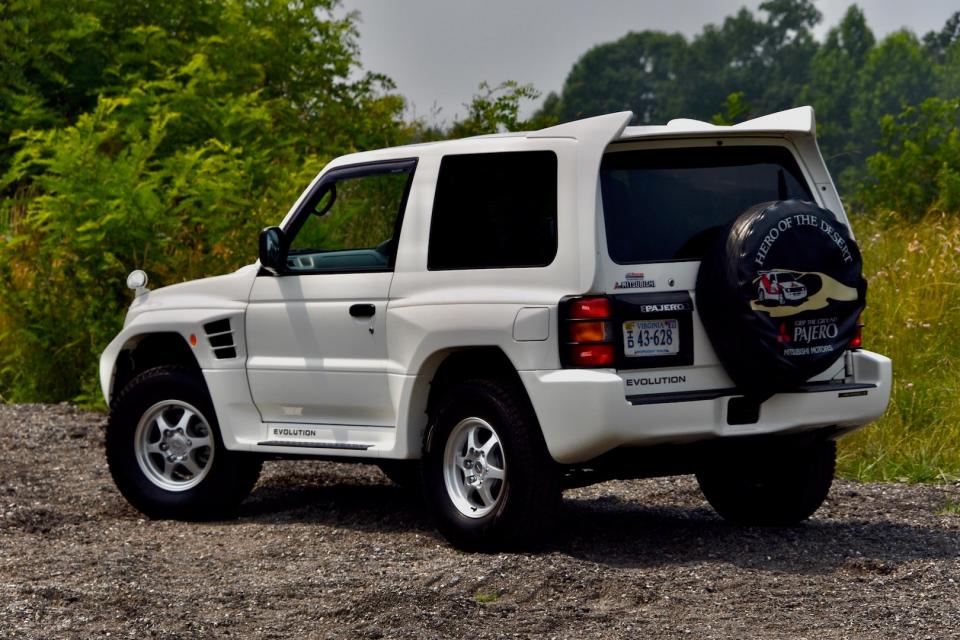
[Editor's Note: JDM Week at The Drive is brought to you by Duncan Imports, one of America's largest importers and resellers of Japanese domestic market vehicles. Big thanks to owner Gary Duncan for opening up his private collection and allowing us to take a few for a spin. If your interest is piqued, you can see the company's full inventory here.]
Over the last decade, the off-roading craze has led other trucks to muscle in on ruggedized performance, and in many ways eclipse the Pajero Evo. However, it’s still distinct as an analog driving experience that can take us back to the innocence of playing "Gran Turismo." It may not be as powerful as a Ram TRX, but that means it’s much more manageable at full throttle.
And that’s what the Pajero Evo is designed to be. It’s not a crawler, it’s a rally truck; it’s designed to be driven flat-out over unfamiliar terrain in a way many modern trucks are too heavy and too powerful to be treated. To use a cliché, it’s the slow-car-fast mentality, but applied to a homologation off-road racer. The Pajero Evo aches to be thrown into steep, sandy, foot-to-the-floor drifts, and on top of it all, it looks like nothing else you’re allowed to put a license plate on.
1997 Mitsubishi Pajero Evolution Specs | |
|---|---|
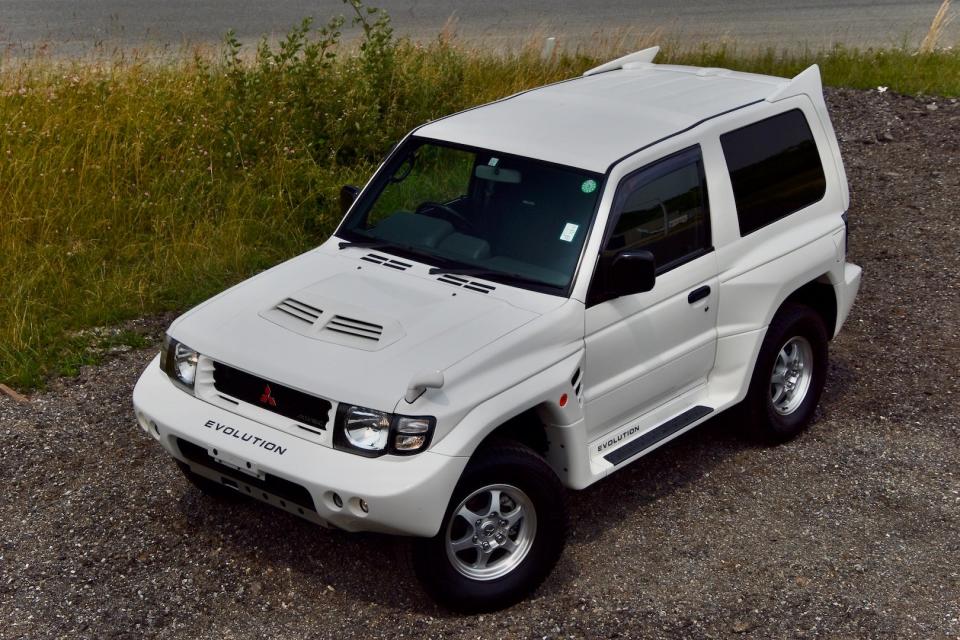

From the Golden Age
The 1997 Mitsubishi Pajero Evolution marked the beginning of Mitsubishi’s most dominant era at Dakar. From 1997 to 2007, Mitsubishi won nine times, disrupted only by purpose-built buggies (that’d later fall prey to developments of the Pajero). To homologate the truck for the T2 class, Mitsubishi built 2,500 roadgoing Pajero Evolutions, from which the race trucks were made. The Evo might’ve had more in common with the race trucks than the SUVs they were based on, though.
Pajero Evos were reworked from the regular body-on-frame Pajero from head to toe, starting where the rubber meets the road. Or sand. It rolled on 30.6-inch 265/70R16 tires on alloy wheels, which stanced it a full six inches wider than a regular Pajero. Despite having fully independent long-travel suspension with double-wishbone front and multilink rear, it has 9.6 inches of ground clearance—about on par with a 2024 Jeep Wrangler.
https://www.youtube.com/watch?v=EWTPJQztIDY
Yet its body is six inches shorter, and a tad narrower despite an enormous widebody. Its wheelbase is shorter than a Toyota GR86’s too. That and stubby overhangs mean phenomenal approach, break-over, and departure angles.
By contrast, the brakes are pretty pedestrian, consisting of enlarged two-piston calipers in front and single-piston rears. They are, however, equipped with four-channel anti-lock, integrated with a steering angle sensor to improve turn-in. Its recirculating-ball steering has a quickened ratio, and much of its underbody is armored in aluminum skid plating that visibly wraps upward around its edges.




Under the hood, the Pajero Evo improved on the regular SUV’s 3.5-liter direct-injection V6 by raising its redline by 1,000 rpm. This was achieved by adding variable valve timing, hollow intake valves, sodium-filled exhaust valves, and titanium valve spring retainers. Though peak torque comes on at a decent 3,000 rpm, peak power doesn’t arrive until 6,500 (redline’s at 7,000).
How much do you get? Well, not a ton to be honest: It’s rated at a Gentleman’s Agreement-abiding 276 horsepower and 257 lb-ft of torque. That’s on premium gas, too. It also has to haul around 4,343 pounds, so the Pajero Evo’s power-to-weight ratio is less than a Subaru BRZ’s—and I’m talking about the old model. That said, it’s still pretty close to what you get from a new Wrangler, although peak torque comes on earlier.




Pajero Evos were built with a choice of five-speed transmissions, a manual or an automatic with a manual mode. Both bolt to a differential-based two-speed transfer case, with a 1.9:1 low range. It can electronically lock the center diff, the mechanical-viscous “hybrid” rear, or any combination of the two as needed. That doesn’t mean it’s out-of-place as a daily, though.
Though it may be a homologation rally truck, the Pajero Evo is well-equipped for a ‘90s SUV. It has a leather steering wheel, keyless entry, power windows, automatic climate control, cupholders, even heated mirrors. The front seats are Recaro buckets, while the rears have child seat anchors, and are designed to fold forward. The back seats also get privacy glass.
There are still reminders of what you’re riding in, though. Carbon fiber adorns the instrument panel and surrounds the A/C vents, clock, and climate controls. It has a compass, oil pressure gauge, and voltmeter front and center, plus an outside temperature gauge because… desert. Back in the tailgate is an emergency toolkit and full-size spare, plus a bottle jack hidden inside the wheel well cover.
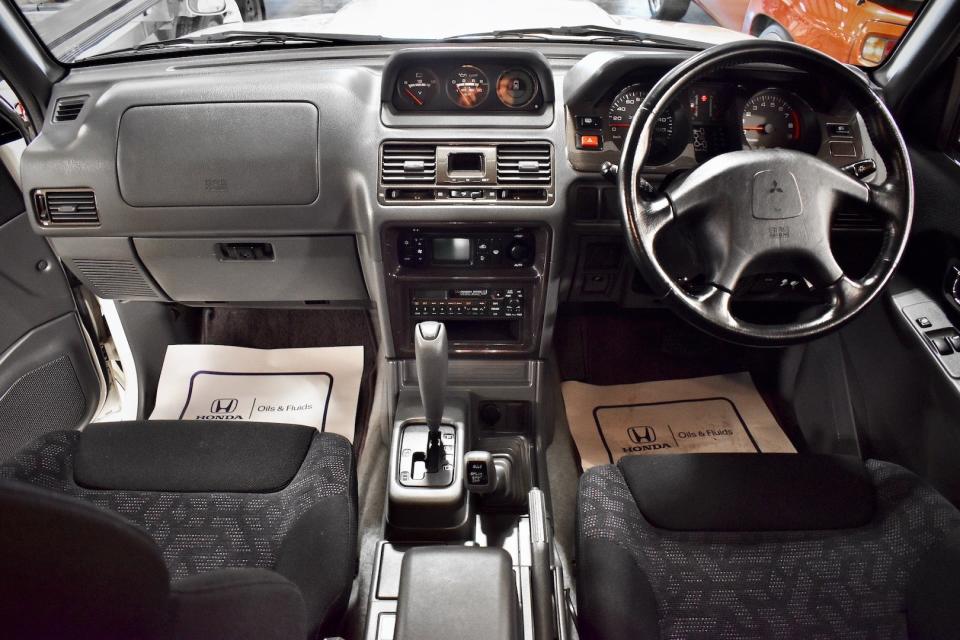

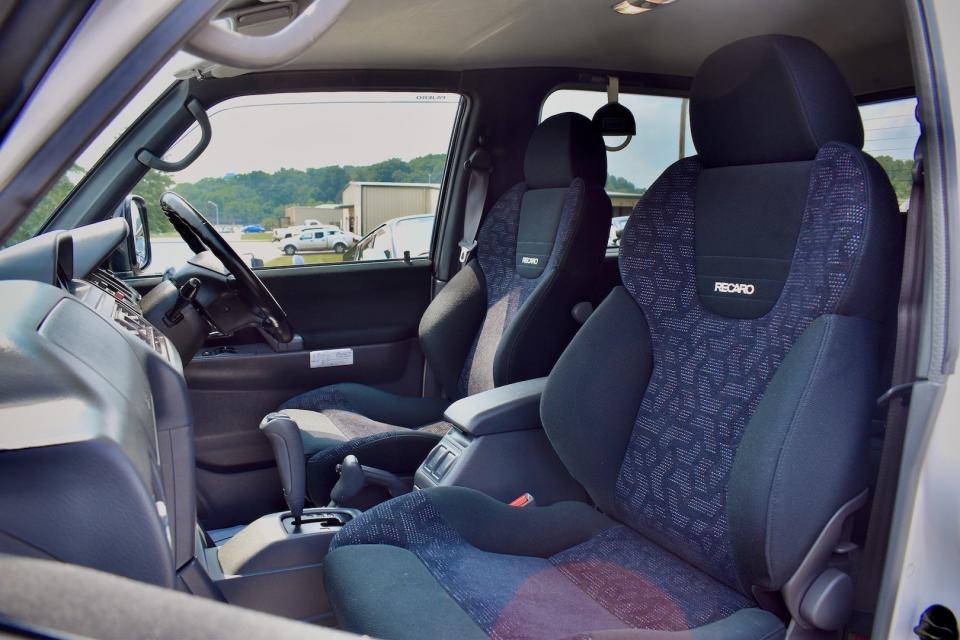

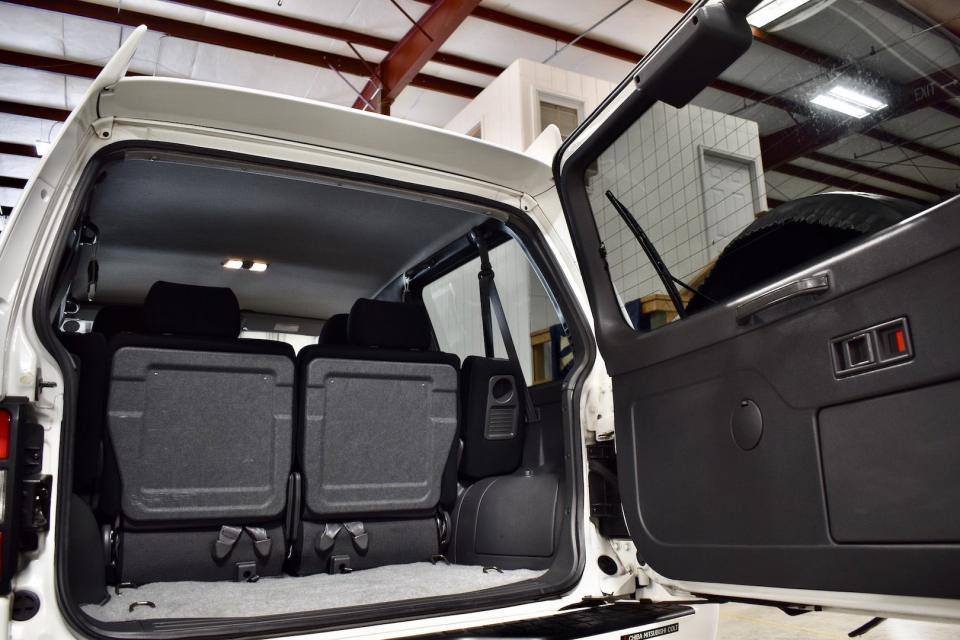

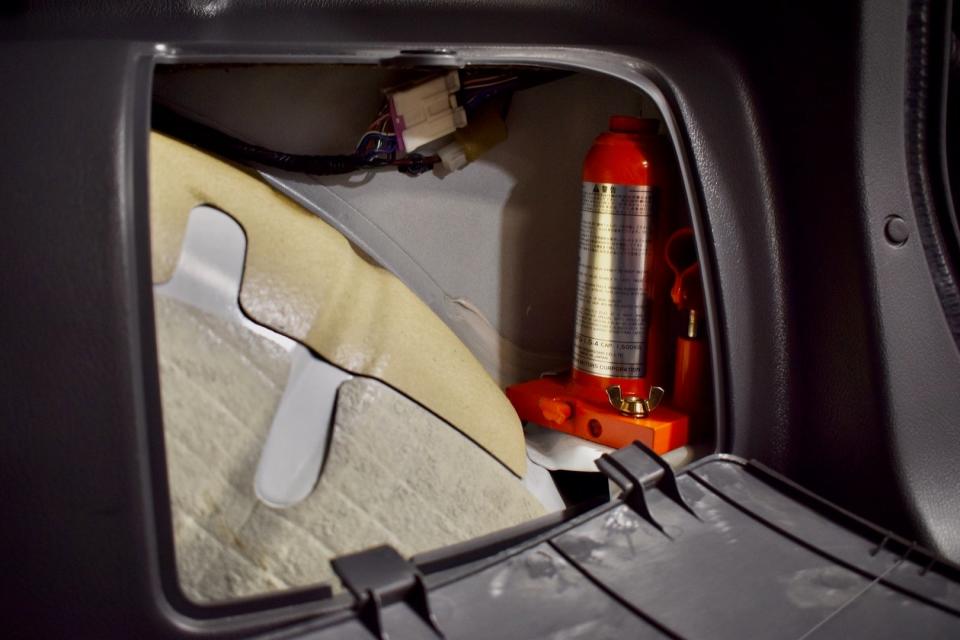

The Countach of Off-Roaders?
That might sound hyperbolic, but I can’t think of any other factory off-roader that has looked this bombastic. It looks like it should be a Hot Wheels. The skid plate follows the lines of the broadened front bumper, which lifts your eyes to its enlarged grille and vented aluminum hood. Its fog lights are puny, and its asymmetrical fender mirror weirdly cute.
Meanwhile, those brawny, vented front fenders blend into the rears by way of an Evolution-emblazoned running board, and its spare tire shroud proclaims it to be the “HERO OF THE DESERT.” Goofy, but justified. Topping it all off is a longtail-style spoiler, jutting out and upward from the rear, topping out in a pair of little devil horns. Or maybe ears, if you prefer a Batmobile comparison. Is it pretty? I dunno. Is it cool? Hell yeah, it is.
Of course, a massive widebody and a ‘90s-tastic spoiler write quite a check for the driving experience to cash. To be honest, I can’t say for sure that it does. That’s more to do with the fact that I didn’t get to try it on its home turf, off the tarmac. But I still got enough of a taste that I ache for the chance to take one of these into the dunes.


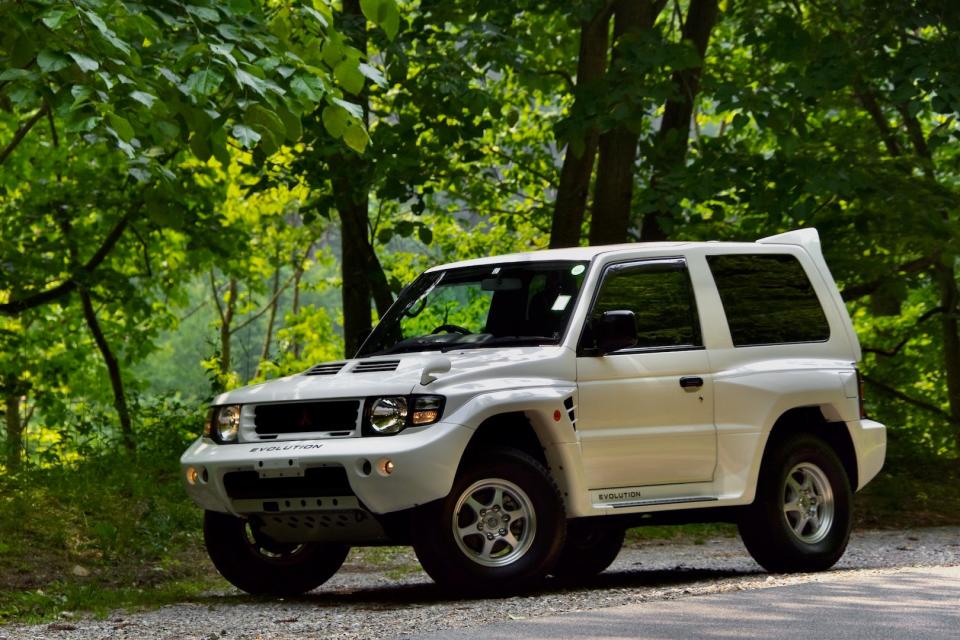
Hero of the Desert
Climbing in, you slip into its Recaros, which aren’t as deeply bolstered as an Integra Type R’s and are therefore more relaxing. Visibility is great: the hood is short and the high driving position, low ‘90s beltline, and truck-size mirrors give a good view of your surroundings. You need it because the Pajero Evo feels wide even on big American roads. That width as we know is in service of handling, which is much more confident than even some modern off-road trucks.
Like all body-on-frame vehicles, it jiggles over bumps, but the suspension’s long travel softens it. The same softness allows for lots of body roll, but its tiny wheelbase enables quick direction changes. Heaving itself down the asphalt at speed, the Pajero Evo exhibits a subtle front-end scrub that warns you to back off before you risk overdoing it.
https://www.youtube.com/watch?v=PQBkrlQHW6E
With modern rubber underneath, this Mitsubishi stops well too, its front diving as the weight transfers forward. That four-channel anti-lock braking kept it stable and never made the truck feel like it was skidding the way many ABS systems do. Plying this into a slow corner with good visibility, I made the rear end twitch—though it stabilized when I came off the brake.
Obviously, I turned right around to try it again: Hot entry under braking kept the front responsive while loosening the rear, yet the weight transferred back the instant I asked it to. I grieve not being able to try this in the desert, because the Pajero Evo is unmistakably designed to be manageable at ten-tenths over unfamiliar terrain. It’s everything you expect of a Mitsubishi calling itself an Evolution.
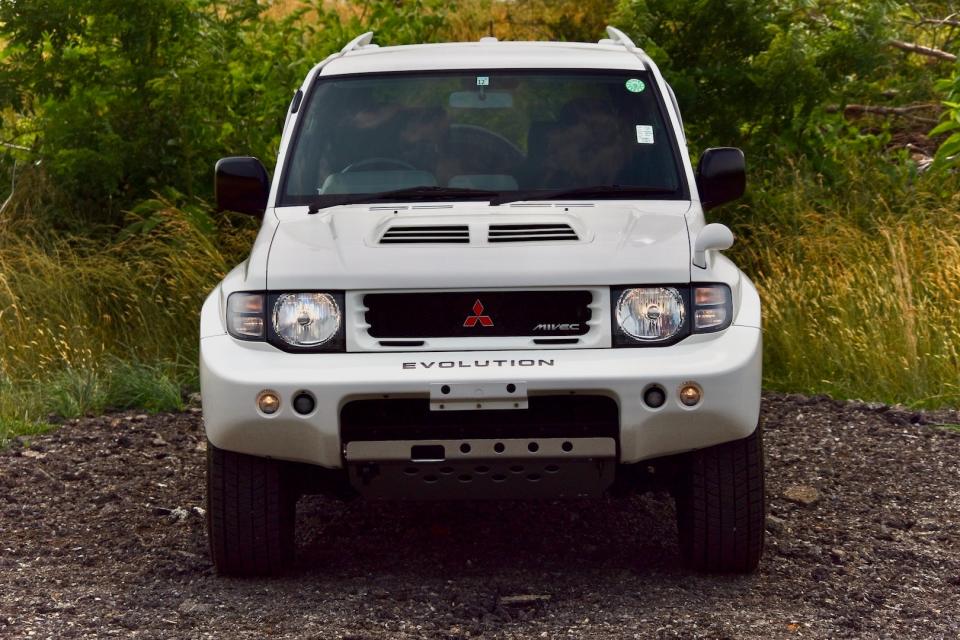
Minus, maybe, how it does in a straight line. Its 3.5-liter V6 may be designed to rev, but it’s still a breathy, low-strung engine without a lot of character. The automatic transmission attached to it is also a ‘90s slushbox, making for full-throttle performance that’d struggle to scare my mom. Its manual mode doesn’t help, it’s not responsive enough to be worth screwing with unless you’re hauling ass. Even then, you’d rather have the manual.
I don’t suspect the manual would make it much less livable every day, either. Cabin noise is reasonable for a ‘90s off-road SUV, especially one that’s a homologation racer—though there are some squeaks and rattles. It is a 26-year-old Mitsubishi, after all.

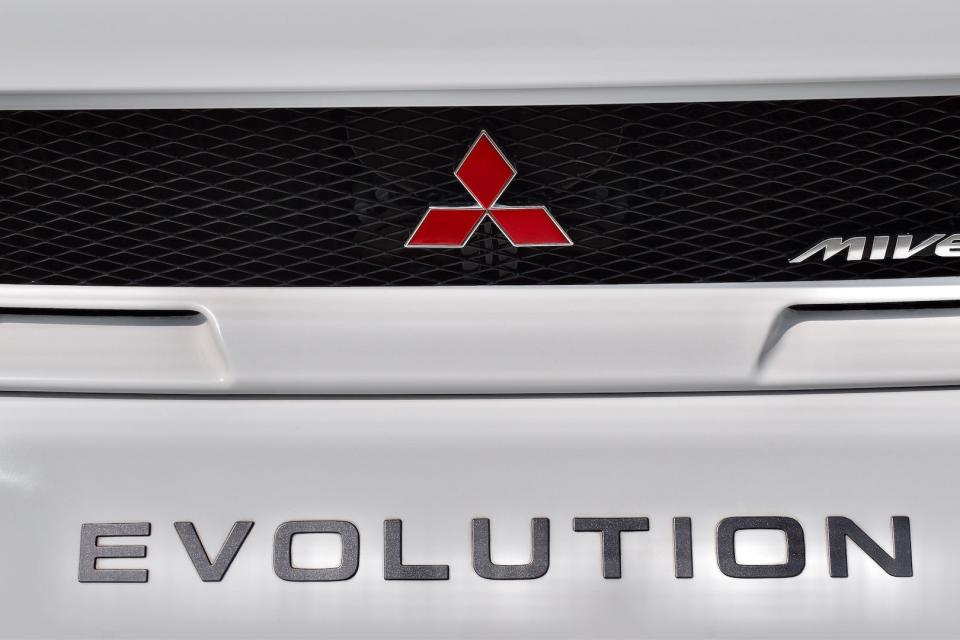
What To Know Before Owning
The Pajero Evolution is based on the SUV we here in the U.S. know as the Montero, which has a cult following as a classic off-roader. Its platform is generally well-supported across the globe, sharing parts with the Delica and other rugged Mitsubishis. Brake master cylinders and tie rods carry over, though the commonality doesn’t go much further.
Because the Evo was a purpose-built homologation racer, not a lot is shared with your average Pajero, and their low production means the aftermarket hasn’t stepped in to fill the gaps. Even basic wear items like OEM rotors and pads are tricky to find. From cross-referencing part numbers, I found that major assemblies from the hubs to the driveshafts, transmission, transfer case, and more are also unique to the Evo. Keeping one of these running—never mind seeing what it can do off-road—isn’t for someone with shallow pockets. Or for that matter, the patience to wait on parts from Japan.




If you can afford a Pajero Evo though, you’re buying into a streetable Dakar-winning homologation car. That gives it a similar distinction to the Porsche 959. There are other raceable desert runners made today, like the Ford F-150 Raptor, but they’re a far larger, more digitalized vehicles. And while a Raptor is an everyday sight in many parts of America, a Pajero Evo is a rarity anywhere it goes.
As for where it goes, its ground clearance, ramp angles, suspension articulation, locking diffs, crawl ratios, and skid plating are more than a match for many crawling trails. Still, its real home is a loose, wide-open surface. This is an SUV truly designed to be thrashed, slid, and bounced around; it’d be incredible fun on a rally stage or rallycross course. That’s what it was built for, after all, yet it’s still civil enough to road-trip.
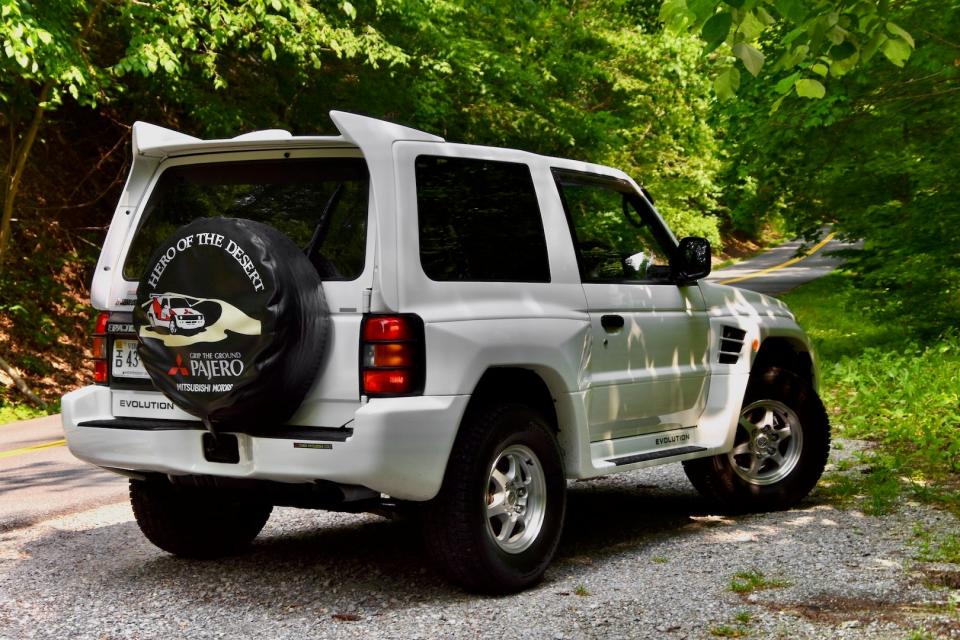
Verdict
The 1997 Mitsubishi Pajero Evolution has been left in a strange spot by the onslaught of modern performance trucks. It’s not as powerful, high-riding, or easy to find parts for as today’s factory off-roaders, but its optimization for rally—for control at its outer limits—is something the newcomers can’t match.
They may have all the low-end torque and computerized traction management in the world at their disposal, but there’s no substitute for hydraulic steering, independent suspension, and a revvy engine. Yet the Pajero Evo can still conquer a trail and is civilized enough to drive in comfort on the road. There’s also a nostalgic element to it, but it’s only superficial. There’s an unforgettable performance truck underneath too, one worthy of calling itself the Hero of the Desert.
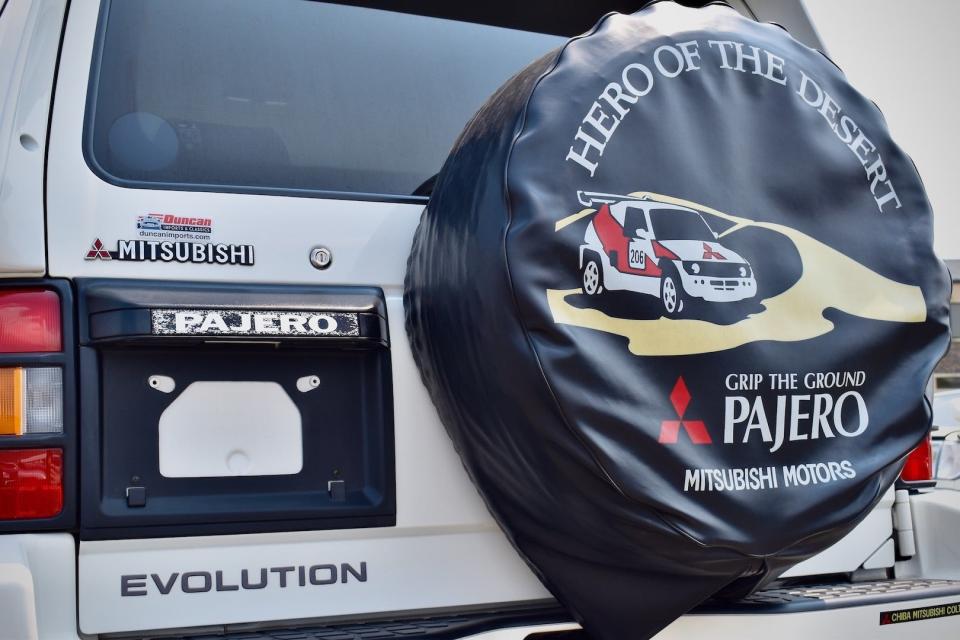
Got a tip or question for the author? You can reach them here: james@thedrive.com

 Yahoo Autos
Yahoo Autos 